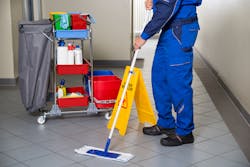Last year, there were 19 million employee absences, and November 2019 was the last time there were fewer than a million in a single month. Presumably, COVID-19 is the clearest reason for this spike, but other factors are at work as well.
Among these are the products we use to clean and disinfect our public spaces. It may not be a coincidence that the uptick in employee absenteeism coincides not only with the pandemic itself, but also the explosion of disinfection that followed in its wake.
In fact, there’s good evidence that those workers who interact with cleaning products the most—janitors—are more likely to call in sick, which is consistent with the higher insurance premiums these workers tend to incur, even compared to other physically demanding jobs.
This shouldn’t be surprising. The chemicals used in most cleaning and disinfection products have been connected to a wide range of medical ailments, including cancer, asthma, organ damage and more. One study compared the effect of regular exposure to “the effect size related to 10-20 pack-years of tobacco smoking.”
Given the financial costs resulting from absenteeism—one CDC study put the total at $225.8 billion per year—no facility manager can afford to take shortcuts when it comes to their employees’ health. Here are a few cleaning trends for 2023 that can help building owners get a handle on the problem.
Training Employees in the Basics
When we ask people to handle dangerous chemicals on a regular basis, we owe it to them to offer the training they need to do so safely.
For example, contrary to common usage, disinfection and cleaning are not the same thing. While both use chemicals that should be taken seriously, disinfectants are often more toxic because they’re designed to kill pathogens, whereas cleaners merely remove dirt and grease.
Another important area of training that is often overlooked is adherence to product label instructions. Many chemicals should not be mixed with others for reasons of safety first, but also because doing so can affect their efficacy. Chemical dilution is another area of concern, where inconsistency in product potency can have harmful effects—too high and there’s a greater risk of health harms for staff, and too low and the disinfectant may not adequately kill microbial cells.
These and other foundational concepts will go a long way towards making your building or facility as healthy an environment as possible.
Replace Cleaning and Disinfecting Products with Safer Alternatives
Even if your facilities team is using products correctly, the chemicals they’re using pose an even greater health risk in the post-pandemic environment.
According to a study on the use of cleaning products during the COVID-19 pandemic and its relationship with increasing health risks, it was observed that cleaning frequency increased 69.3%, product usage increased 74.2%, and subsequently, the frequency of health problems related to the use of cleaning products increased to 46.9%.
While consumer and commercial behavior has driven increased frequency and efficacy of cleaning, we need to consider the risks of continuing to use products that harm our health and find alternatives that are less hazardous—or ideally, not harmful at all. Replacing harmful and toxic chemicals in the built environment with safer solutions will help you reap the many benefits of a healthier workforce.
Looking Deeper than “Green” Cleaners
Green cleaners can be a great way to reduce the use of harsh chemicals in your facility. But the key word is can.
The trouble is that there are no regulatory standards governing terms like “green” and “natural.” Much of what is marketed as natural alternatives to traditional products are also dangerous to human health or damaging to the environment.
Added fragrances are a common culprit, in part because under the Fair Packaging and Labeling Act, they usually qualify as trade secrets, which means companies don’t have to disclose them. Harmful chemicals like phthalates—connected with infertility, birth defects, and heart disease—are often smuggled into cleaning products through this loophole.
To be clear, this doesn’t mean that the search for green alternatives is hopeless; it’s just that building owners and facility managers shouldn’t let a marketing spin take the place of thorough research.
Keeping an Eye on Emerging Technologies
The uptick in green cleaning reflects the fact that our society is becoming more health-conscious. Addressing the health risks posed by harsh chemicals will therefore only become more of a priority for innovators.
Legitimate progress along these lines is already well underway. There are multiple types of products that claim to eliminate toxicity entirely, but one of the most exciting on the market today is electrolyzed water.
By passing an electric charge through a solution of water and salt (producing a chemical reaction called electrolysis), new technology can produce a multi-purpose cleaner and degreaser, as well as a disinfectant that is 80-120 times stronger than bleach. Yet for all that potency, there are no harmful chemicals or ingredients—again, it’s just salt, water, and electricity.
In other words, those who want to maximize the health of their workforce using forward-thinking disinfection practices may just find that the future they’re looking for has already arrived. And that’s good news for all of us.
About the Author
Joshua Schwartz
Joshua Schwartz is the co-founder and president at Viking Pure Solutions, a sustainable cleaning innovation company that is changing the way facilities clean and disinfect with non-toxic, on-demand solutions that are better for people and the environment. He is an active developer of medical real estate and supportive housing.
